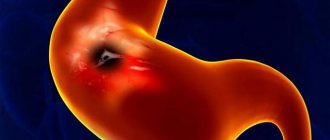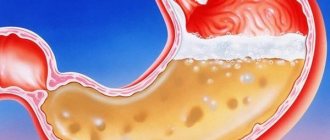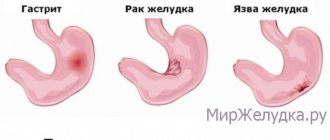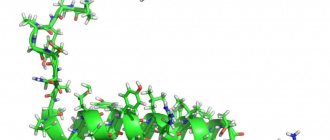Basic data
| Main types of disease | |
| Acute gastritis | Occurs when overeating, eating too spicy or rough food that is unusual for the body, as well as as a result of excessive consumption of alcohol and cigarettes. Most often, acute gastritis, the types and forms of which are discussed in detail in the article, has a mild form, in which hospitalization is not required. |
| Atrophic gastritis | Inflammation of the gastric mucosa, as a result of which the number of healthy cells in the tissues begins to rapidly decrease. If left untreated, it can become chronic and trigger the formation of cancer cells. Therefore, before starting treatment, you should first find out what atrophic gastritis is, the types, causes and treatment of which, depending on the pathology and course, are discussed in detail in the article. This is the only way you can get the maximum benefit from treatment. |
| Chronic gastritis | Inflammation of the gastric mucosa, which has a detrimental effect on its performance. It often occurs in people who have repeatedly suffered from an acute form of gastritis without consulting a doctor. |
| Gastritis with increased acidity | This form of the disease has an extremely detrimental effect on the mucous layer of the stomach, since with a high level of acidity, the body produces hydrochloric acid in large quantities, which in large quantities can cause burns. If left untreated, burns will eventually develop into ulcerations and erosions, often causing bleeding. It is quite difficult to cure such a pathology, because in the most damaged areas an ulcer or, in the worst case, stomach cancer can form. Therefore, knowing what types of gastritis with high acidity there are, you can detect the disease much faster and consult a doctor. |
| Antacid gastritis | Occurs when the gastric juice does not produce enough acid. In essence, it is, although rare, but quite difficult to treat, inflammation of the gastric mucosa, to eliminate which it is necessary to use complex treatment. |
Remember that when treating all types of gastritis, a strict diet is required. At the same time, it is better to discuss the selection of products that are suitable for you in this condition with your doctor, since the diet will directly depend on the form in which the disease manifests itself. In any case, be prepared for the fact that you will have to give up eating spicy and fried foods, as well as alcohol.
Next, you can learn in more detail about the types of gastritis and their treatment, as well as find out what preventive measures will help prevent their recurrence.
Pathogenesis and etiology of the disease
According to the etiological mechanism of formation, acute gastritis is divided into endogenous and exogenous.
The occurrence of acute endogenous gastritis depends on the presence of infections in the body. The main reason is the presence of the bacterium Helicobacter pylori, which is detected in 80% of patients diagnosed with acute gastritis. Helicobacter bacteria secrete various toxins, under the influence of which inflammatory reactions begin to develop in the gastric mucosa. This bacterium also contributes to the appearance of gastric ulcers.
Less commonly, the causative agents of gastritis of the endogenous mechanism (infectious, for example) are staphylococci, streptococci, Escherichia coli, Proteus, causative agents of fungal infections, cytomegalovirus, and others. Functional and morphological prerequisites for the appearance of this type of gastritis occur with scarlet fever, influenza, viral hepatitis, measles, pneumonia, diphtheria. In some cases, acute gastritis of secondary etiology can occur with secondary syphilis or disseminated tuberculosis.
The etiological causes of acute exogenous gastritis are food agents - mechanical, thermal, chemical. Irritation of the mucous membrane by hot, rough, spicy food can cause the development of acute gastritis. They also have an adverse effect on the stomach and can act as irritants:
- dry food;
- poorly chewed food;
- overeating or an overly strict diet;
- eating a large amount of spicy, fried, salty, smoked foods and food seasoned with vinegar, pepper, mustard.
Frequent consumption of alcohol, strong coffee, and smoking have a damaging effect on the mucous membrane of the digestive organ.
Exogenous causes often include food poisoning, which is caused by eating foods contaminated with Shigella, Salmonella, Yersinia, and Klebsiella. Also, damage to the mucous membrane and its irritation can be provoked by prolonged use of certain medications - sulfonamides, glucocorticoids, salicylates, iron preparations, bromides, antibiotics.
Acute gastritis can manifest itself against the background of radiation therapy in the treatment of gastric oncology (radiation gastritis), accidental (or intentional) penetration into the stomach of chemicals (compounds of iodine, acetone, arsenic, nitric, phosphoric, sulfuric, acetic, hydrochloric acids, ammonia, caustic soda and others). With large concentrations or volumes of toxic substances entering the body, a burn may occur or perforation of the wall of the esophagus and stomach may develop.
Acute allergic gastritis can develop due to personal intolerance to certain types of foods and may be accompanied by other allergic reactions - angioedema, urticaria, an attack of bronchial asthma.
Damage or inflammation of the mucous membranes is also caused by frequent endoscopic examinations, the study of gastric secretion with the support of probes and pH meters. Mechanical damage to the walls of the stomach is also undesirable - injuries from blows, bruises, intense physical activity or foreign objects entering the stomach (poultry bones, fish, chips, needles).
Stress, neuroses, and depressive disorders are also considered risk factors.
Atrophic gastritis
Atrophic gastritis is one of the most unpredictable types of the disease. This is directly related to the fact that at the initial stage it is practically asymptomatic. In addition, the minor discomfort that it causes can easily be mistaken for a normal ailment, however, knowing the main types of gastritis and the symptoms of the disease, you will be able to detect its presence much faster and consult a doctor. However, remember that it most often develops in older men.
Under the influence of a number of reasons, gastric cells cease to produce sufficient quantities of gastric juice elements, producing mucus instead.
Despite the fact that atrophic gastritis, the types of which are presented below, is most often accompanied by the presence of increased or decreased levels of acidity in the stomach, its main danger lies in the fact that, according to numerous studies, it is a harbinger of the occurrence of cancer cells.
Main symptoms:
- After eating food, even in small quantities, a feeling of heaviness and discomfort appears in the solar plexus area.
- Even with regular visits to the dentist and completely healthy teeth, there is an unpleasant odor from the mouth. In addition, minor ulcers may form in the oral cavity.
- There is periodic rumbling in the stomach.
- Flatulence, constipation or diarrhea may occur.
- The patient's weight decreases sharply.
- Anemia develops, during which headaches appear, the skin becomes pale yellow, and the tongue periodically begins to tingle.
- Hormonal levels are disrupted, which can lead to early menopause.
Atrophic gastritis, the types and forms of which are discussed in this article, requires studies such as gastroscopy or endoscopy. With their help, the doctor will be able not only to understand how thin the walls of the stomach have become, but also to find out how damaged the gastric glands are.
In addition, a number of modern clinics use a gastropanel to detect atrophic gastritis, which allows a non-invasive assessment of the condition of the gastric mucosa.
New classification
According to the new classification developed by German scientists, the following forms of this disease are distinguished:
- autoimmune;
- Helicobacter;
- mixed;
- chemical-toxic;
- lymphocytic;
- special types.
At the present stage of medicine, an accurate diagnosis can be made thanks to a complete examination, correct test results and a detailed description of the disease. Most often in practice, doctors use the detailed classification of Ryss, and the other types of gastritis presented remain its addition.
The concept of gastritis is a morphological diagnosis, which refers to changes in the gastric mucosa of a dystrophic-inflammatory nature.
From the point of view of medical nomenclature, this is not a clinical diagnosis. Here we need to move away from the topic and consider the concepts of morphological and clinical diagnosis.
The first is an integral part of the second. However, equivalent correspondences between morphological and clinical diagnoses are not always present.
Using the example of the diagnosis we are considering, its clinical equivalent will be functional dyspepsia - a common disorder of the digestive system, which is diagnosed based on the results of a clinical examination. Gastritis may not have clinical manifestations and is diagnosed by morphological changes in the body. More specifically, in the stomach.
But in Russian medicine it is customary to use the clinical diagnosis of gastritis. And let’s talk about it, keeping in mind functional dyspepsia, as the nomenclature-correct version of the name.
How does pathology manifest itself?
Depending on the stage at which atrophic gastritis is located, the types of disease are divided into 4 forms:
- Superficial. This is the initial stage of the disease. It is just the first sign that inflammation may appear on the gastric mucosa. Determined only by endoscopy. If a doctor uses an instrumental method of examination, then with its help he can most often determine what the thickness of the gastric walls is, at what stage the epithelial degeneration is, and, by indirect signs, establish the state in which cell hypersecretion occurs.
- Spicy. Inflammatory processes in the gastric mucosa begin to develop rapidly. Tissue edema occurs, destruction of the epithelium occurs, which can even lead to erosion of the mucosa, as well as infiltration of leukocytes outside the stomach.
- Moderate. Gastric cells are partially transformed. In order to identify gastritis at this stage, the doctor will need to examine the gastric mucosa for affected cells. In addition, in some cases, an analysis is carried out that shows how much the tissue has undergone changes.
- Chronic.
Diagnostics
Summing up the symptoms of the disease, we come to the only correct conclusion: The pathology can be diagnosed by instrumental examination. Symptoms and the collected medical history allow us to make only a presumptive diagnosis.
An accurate diagnosis is made using gastroscopy. Gastroscopy is an examination of the condition of the stomach walls with a gastroscope. It is introduced into the stomach through the mouth. After gastroscopy and diagnosis, a second stage of instrumental examination is prescribed, which determines the type of disease.
This diagnostic stage consists of four studies: 1. Biopsy of material taken during gastroscopy. A biopsy involves taking five tissue samples. Two are taken from the antrum (the lower part of the stomach located in front of the pylorus), two from the body of the stomach and one from the angle of the stomach. Biopsy objectives:
- detection of the bacterium Helicobacter pylori in gastric tissues;
- identification of areas of changes in the gastric mucosa;
- diagnosis of precancerous markers.
2. Complete laboratory diagnostics consists of:
- clinical blood test,
- blood biochemistry,
- clinical urine analysis,
- clinical stool analysis,
- stool occult blood test.
The steps in this test identify the bacterium Helicobacter pylori. 3. Diagnosis of reflux. To diagnose the chemical type of disease, it is necessary to identify sphincter dysfunction. You can do this in two ways:
- electrogasteroenterography – registration of biopotentials of various parts of the gastrointestinal tract;
- manometry of the upper gastrointestinal tract.
4. Measurement of acidity in the gastrointestinal tract. pH-metry inside the stomach determines the quality of secretory function and functional disorders in diseases of the gastrointestinal tract associated with changes in acidity.
Types of disease
What types can this form of the disease take?
The table below will help you understand this. Types of atrophic gastritis
| Antral | In the lower part of the stomach, in the immediate vicinity of the duodenum, a small compacted “tube” is formed, in the form of which this type of gastritis manifests itself. The affected areas of the stomach become deformed, becoming covered with peculiar scars. The acidity level with antral gastritis either decreases slightly or remains at the same level. In addition, with this type of disease, some patients begin to develop ulcerative processes in the oral cavity. |
| Focal | Areas with pronounced pathological processes appear in the gastric tissues. In rare cases, an increase in acidity levels may be observed, which is directly related to the fact that healthy areas of the stomach completely compensate for the work of the affected ones. |
| Diffuse | It is the main harbinger of the onset of dystrophic changes. Its main symptom is that the gastric glands gradually degenerate, as a result of which their normal activity is disrupted and immature cells begin to appear more and more often. In addition, deepening of the gastric pits can be a clear sign of the disease. |
Treatment methods for atrophic gastritis
Due to the fact that there are many forms and types of atrophic gastritis, doctors have not yet developed a unified method of treating them. This is directly related to the fact that cells damaged as a result of this type of disease are not restored.
However, after an individual examination, the doctor can formulate the optimal treatment method for each individual patient and prescribe an appropriate diet.
Prevention measures
The disease can be prevented using a set of measures aimed at reducing the negative effects on the gastric mucosa. This requires:
- Move more.
- Avoid excessive stress on the body, avoid stressful situations and emotional stress.
- Eat properly. Use only quality products. Meals should be taken strictly at certain times in small portions. Eliminate spicy, fried, salty foods from your diet.
- Be examined by a gastroenterologist at least once a year. This will allow you to identify the disease at an early stage and begin treatment on time.
At the first symptoms that raise suspicion of gastritis, it is necessary to undergo an examination. This is the only way to avoid the disease becoming chronic and the complications associated with it - peptic ulcers, stomach cancer.
Chronic gastritis
If you do not consult a doctor if acute gastritis occurs or do not strictly follow all the recommendations that he gave you regarding its treatment and prevention, over time the disease takes on a chronic form.
In addition, even a number of exogenous factors can influence its occurrence, for example, if you have been disrupting your diet for a long time. Types of chronic gastritis
| For reasons of occurrence | |
| Endogenous | Occurs in cases where acute gastritis is complicated by the presence of heart and infectious diseases, allergies and diabetes. It also occurs when the diet is not followed, teeth are missing, as a result of which food enters the stomach practically unchewed, thereby putting an excessive load on it. |
| Exogenous | Most often occurs in people who come into contact with chemicals for a long time. For example, people working in chemical production. |
| For the production of gastric juice | |
| With high acidity | Gastric juice is secreted in too much volume. |
| Low acidity | The secretory function of the stomach is significantly reduced. |
| Types of chronic gastritis of the stomach according to histological characteristics, detected by biopsy | |
| Non-atrophic | The gastric glands are affected, but do not atrophy. |
| Subatrophic | The gastric glands partially atrophy. |
| Mixed | Inflammation of the mucous membrane can suddenly change to a more serious lesion, as a result of which the stomach tissue can atrophy. |
In addition, all chronic gastritis can be divided according to the localization of the process in the gastric sections into cardiac, body gastritis and antral.
Houston classification
In this case, scientists distinguish types of chronic gastritis, based on different categories and etiology of the disease. In this theory, gastritis has certain varieties that do not have a study of secretory function and the stages of the disease are not taken into account. According to the creators of the classification, chronic gastritis occurs:
- non-atrophic anacidic or hypoacid - the body is affected by the bacterium Helicobacter pylori;
- atrophic antral diffuse - develops from an autoimmune process;
- atrophic multifocal diffuse - progresses due to poor nutrition, damage to the secretion of gastric juice or from the bacterium Helicobacter pylori;
- chemical - provoked by bile or frequent use of drugs;
- radiation - due to radiation damage;
- lymphocytic - due to immune disorders and the bacteria Helicobacter pylori;
- erythematous - the deep layers of the organ are not affected;
- exudative - progresses under the influence of chronic ailments;
- follicular - rarely diagnosed.
The developers of this classification did not base their achievements on the clinical and functional properties of the disease, so in practice doctors do not use it.
Treatment methods for chronic gastritis
Knowing what types of gastritis there are, you can determine much faster when the disease becomes chronic, which will help you consult a doctor in a timely manner to take action. Remember that if you do not pay attention to gastritis for a long time, then ulcers or even cancer cells may appear on the walls of the stomach. So that the doctor can accurately determine the type of illness and adjust the treatment, a number of medical examinations are prescribed, for example, gastroscopy, a blood test or measuring acidity levels.
Chronic types of gastritis of the stomach always require an integrated approach to their treatment, in which the diet will be combined with a number of medications that coat the walls of the stomach. In addition, medications can have an adsorbent and antacid effect. In any case, medications should be taken several hours after meals, when the tablets will reduce the severity of inflammation of the mucous membrane and allow the stomach to calmly digest food.
"Working" classification
Practitioners use other types of gastritis of the stomach from Dr. M. S. Ryss. This classification is working and is actively used to diagnose chronic gastritis.
The disease is classified according to the type of inflammation:
- surface;
- atrophic – multifocal and with unknown etiology;
- other forms of the disease - reactive, radiation, lymphocytic, granulomatous, eosinophilic, giant hypertrophic and others.
The disease can form in:
- antrum of the stomach;
- body of the stomach.
Based on the endoscopic picture, clinicians distinguish:
- surface;
- erosive;
- atrophic in nature;
- with bleeding (hemorrhagic);
- mucosal hyperplasia.
According to the morphology, gastritis is determined by:
- stages of inflammation;
- activity of the inflammatory process;
- the presence of atrophy of the gastric glands;
- the presence of a predisposition to the oncological process;
- stages of bacterial development.
Based on their functional characteristics, they are distinguished:
- secretion with normal levels;
- increased level of secretion;
- secretory insufficiency.
Clinical symptoms of gastritis also indicate certain stages of the disease:
Based on knowledge of the types of gastritis, the following types of pathological processes can be distinguished:
Gastritis with high acidity
All types of gastritis with high acidity develop due to excessive production of digestive secretions by the stomach. The main sign of their occurrence is the presence of aching pain that occurs on an empty stomach or a few hours after eating. The pain is directly related to the contact of hydrochloric acid and the inflamed gastric walls and can be localized in the epigastric zone or left hypochondrium.
Types of gastritis with high acidity:
- Chemical.
- Fundal.
- Antral.
Although the symptoms of each of these types are very similar, the underlying causes that influence their occurrence are different.
It is noteworthy that the occurrence of the disease can be influenced not only by the presence of bad habits or the bacterium Helicobacter pylori, but also by a genetic factor, as a result of which even fundic gastritis can appear. In some cases, the occurrence of any type of gastritis with high acidity can even be affected by a lack of oxygen resulting from injuries or systemic diseases.
What is gastritis of the stomach
General gastritis is an inflammation of various forms of the gastric mucous layer; the disease disrupts the functioning of the organ.
Inflammation prevents food from being digested normally; over time, this leads to other pathologies, as well as a decline in the body’s strength.
Like most diseases of the intestinal tract, gastritis has two forms - acute and chronic.
There is also a difference between pathology with high acidity and low acidity (achylic type).
For a long time, gastritis has been considered a disease of the century. This is due to the fact that it affects both adults and children.
According to statistics, in every CIS country at least 50% of residents have different types of gastritis.
Pathologies develop based on external and internal causes provoked by gastritis.
The disease occurs clinically in one form or another. Acute inflammation has a short-term effect.
When the intestinal mucous membranes are damaged, a concentration of acids, chemicals and alkalis occurs, all of which are deadly.
Treatment methods for gastritis with high acidity
The treatment of gastritis with high acidity should be carried out by a highly qualified specialist who will develop treatment, based on the results of tests and further annual diagnostics, and will be able to select the optimal correction option, changing it depending on the development or attenuation of the disease. In addition to palpation, the disease can be diagnosed by examining gastric juice. Thus, the doctor will be able to timely determine not only the form, but also the stage of gastritis, and also find out whether the bacterium Helicobacter pylori influenced its development.
It is noteworthy that when developing a treatment regimen, it is not the level of acidity that is first assessed, but the state in which the gastric mucosa is located. If gastritis with high acidity is acute, then at the first stage the doctor prescribes medications that can reduce pain and eliminate inflammation.
Causes
Main signs of stomach pain
Painful sensations in the stomach most often occur in the epigastric region. The pain can be varied: dull, sharp, constant, cutting, diffuse.
One of the main causes of stomach pain is considered to be a disruption in the functioning of this organ. In most cases, pain occurs with such diseases.
- Gastritis.
- Stomach polyp.
- Food poisoning.
- Stomach cancer.
- Stomach pain may be due to a malfunction of this organ or damage to the gastric mucosa. Sometimes the cause of pain can be increased sensitivity to certain foods.
- Very severe pain is diagnosed in the presence of pancreatitis.
- The presence of viral and bacterial infection. Sometimes an infection can remain in the body for a long time and the signal drops only when the immune system is weakened.
- Inflammatory processes in appendicitis.
- Diaphragm spasm.
- Presence of cardiovascular diseases.
Acute gastritis
An inflammatory process that affects the gastric mucosa is called acute gastritis. It can appear at any age, so at the first symptoms you should immediately consult a doctor.
Types of acute gastritis
| Catarrhal | Observed in most cases. Covers the surface of the gastric walls, as a result of which the stomach begins to intensively produce mucus, which can cause edema or hyperemia. If acute gastritis is triggered by an allergen entering the stomach, a reaction in the form of a rash, swelling or redness appears on the skin within a few minutes. With this type of gastritis, the stomach walls become significantly thicker due to accumulated mucus. In addition, various defects appear on their surface in the form of ulcers, hemorrhages, or coating with serous exudate, from which the epithelial cells gradually die. |
| Corrosive | Appears due to poisoning with concentrated chemicals. Moreover, according to the form of pathology, corrosive gastritis can be divided into coagulation (dry) and liquefaction (wet) necrosis. In rare cases, such as chemical poisoning, it can lead to the development of heart, liver or kidney failure. In this case, the walls of the stomach can become so damaged that its contents leak into neighboring organs. |
| Fibrinous | The main reason for its appearance is infectious diseases caused by various types of poisoning, as a result of which the gastric mucosa undergoes serious changes. If fibrinous gastritis develops into purulent exudate, inflammation forms a kind of film on the outside of the gastric walls, under which the tissues transform into loose compounds. It is noteworthy that if the tissue damage is not severe, the film is easily removed, so during vomiting its elements can be found in the masses. |
| Phlegmonous | It is a pronounced purulent gastritis, developing due to violations of the integrity of the mucous membrane. Inflammation occurs as a result of injury to the gastric walls by foreign objects, for example, if the patient swallows a large fish bone or needle. These changes affect all layers of the stomach, including the serous membrane, as a result of which the patient develops peritonitis or perigastritis. |
Special forms
Includes a list of species that did not find a place in other sections: eosinophilic, reactive, radiation and others.
Localization of gastritis
Location in the area of the body of the stomach, antrum or both parts, covering both curvatures of the stomach. Prevention of gastritis and timely treatment is necessary so that the lesion does not spread over the entire surface of the stomach.
Cause of the disease:
- Infectious lesion of the mucous membrane caused by Helicobacter pylori;
- Other factors of a non-infectious nature: exposure to alcohol, chemicals (medicines), radiation injuries, allergic reactions to food, gross disturbances in diet, frequent reflux of intestinal contents into the stomach;
- Autoimmune aggression against the body's own cells;
- Other unknown factors.
Endoscopic picture of the lesion
- Exudative or superficial is a common option;
- Erosive;
- With atrophy of the mucous membrane;
- Chronic with hemorrhages;
- With areas of metaplastic epithelium;
- Hyperplasia of the gastric mucosa;
- The presence of the picture and consequences of reflux disease.
According to clinical manifestations
According to the clinic, chronic gastritis is divided into 2 phases: exacerbation and remission. In turn, the classification of the acute variant includes the following types: catarrhal gastritis, characterized by an abundant amount of mucus covering the walls of the stomach, swelling and congestion of the lining cells of the stomach.
If there are small hemorrhages against this background, it speaks of another type of acute gastritis - erosive.
- Fibrinous gastritis is manifested by the presence of purulent discharge on the surface of the mucosa with small fibrous connective tissue strands. Types of inflammation of the mucous layer include 2 types: superficial, or croupous, gastritis, which is distributed within only the superficial layer. Deep, or diphtheritic, in which strands of connective tissue invade the other linings of the stomach, leaving deep scars.
- Acute phlegmonous type - characterized by the involvement of all layers of the stomach with the formation of necrosis and deep ulcers. Prevention of the disease and timely treatment will help avoid severe manifestations.
By stomach function
- Gastritis with normal secretory activity;
- Hyposecretory type;
- Hypersecretory type.
According to the morphological picture
The section includes a description of the gastric wall according to what was seen during FGS. Treatment and further tactics, to a large extent, depend on the description. The degree of inflammation, its activity are described, areas of atrophy of the gastric glands, if any, are indicated. Metaplasia and its type. The degree of Helicobacter pylori contamination of the gastric mucosa.
According to the presence of complications
Complications occur in advanced cases, with untreated gastritis, and are of two types:
- Bleeding from erosions, ulcers of the gastric mucosa.
- Malignization.
Treatment of acute gastritis
If the patient is taking any medications, be sure to tell the doctor about it so that he can prescribe the correct treatment. In addition, even if gastritis no longer appears, you should visit a gastroenterologist regularly.
Acute gastritis, the types, causes, prevention and treatment of which are discussed in this article, require mandatory adherence to a special diet. In addition, after the initial manifestation of the disease, the patient is recommended to fast for 24 hours so as not to burden the stomach.
When treating acute gastritis, one should concentrate on eliminating the root cause that provoked its occurrence. If acute gastritis was caused by chemical poisoning, gastric lavage is required.
Antacid gastritis
If the stomach cannot cope with producing enough acid, a hypoacid form of gastritis appears, which, in the absence of proper treatment, quickly transforms into an antacid form, in which there is too little hydrochloric acid in the gastric juice. As a result of this, food is not digested properly, the digestive process becomes difficult, and in severe forms of antacid gastritis, even impossible. Most often it is diagnosed in elderly patients, manifesting itself in the form of discomfort in the stomach that occurs immediately after eating.
Most often, antacid gastritis develops due to poor diet, stress, poor heredity or a weak immune system, which prevents the gastric tissues from producing enough antibodies.
Symptoms
Clinical signs of the disease depend on the location of inflammation, secretory activity of the glands, and the depth of damage to the mucosa.
Symptoms of hyperacid gastritis
Chronic gastritis with normal and high secretion most often occurs in young patients, more often in men. Patients complain of pain in the stomach, sour belching, heartburn, constipation, a burning sensation in the epigastric region, and occasionally vomiting.
The disease occurs with episodes of exacerbation and lull. Exacerbation of gastritis often coincides with the consumption of strong alcohol, violation of diet and regularity of food intake. Sometimes the disease takes a continuous course, characterized by persistent dull pain, without a specific localization. Pain can occur immediately after eating, these are the so-called early pains. In other cases, they bother the patient at night or on an empty stomach (hunger pain and night pain), this is more typical for type B gastritis.
Symptoms of hypoacid gastritis
Secretory insufficiency is more common in adulthood and old age. Typically, in such patients, atrophic changes in the mucosa of varying severity are found. Pain may be absent or mild. Symptoms of dyspepsia come to the fore: heaviness in the abdomen, upset stool, belching of air or eaten food, bloating.
Patients experience loss of appetite, decreased body weight, fatigue, and physical inactivity. With atrophic gastritis, symptoms of hypovitaminosis are often observed: dry skin, catches in the corners of the mouth, red rough tongue.
Due to low acidity, the bactericidal properties of gastric juice are reduced, so patients often suffer from food poisoning, salmonellosis, dysentery and other infectious diseases.
Often, patients with chronic gastritis are concerned about intestinal disorders, which are clinically manifested by diarrhea, flatulence, attacks of intestinal colic, and abdominal distension. Sometimes diarrhea alternates with constipation; a characteristic disorder for such patients is intestinal dysbiosis.
Symptoms of reflux gastritis
The disease is characterized by the entry into the stomach, or more precisely into its outlet section, of bile components, pancreatic juice, and lysolecithin. All these substances irritate the walls of the stomach, causing inflammation.
Patients complain of a bitter taste in the mouth, heartburn, flatulence, and heaviness in the stomach after eating. Sometimes vomiting with bile and upset stool occurs.
Unpleasant symptoms that appear after eating force patients to reduce the amount of food they eat; in addition, due to the disruption of the inner lining of the stomach, nutrients are poorly absorbed by the body. All this leads to weight loss, weakness, and vitamin deficiency.
Treatment of antacid gastritis
For antacid gastritis, treatment with enzyme medications that promote food digestion must be combined with a strict diet. If gastritis has affected the normal functioning of the intestines, patients are prescribed medications that have a stimulating effect on its functioning. In addition, in this case, you should follow the correct, hourly diet and in no case overeat. At the same time, remember that it is currently impossible to completely cure antacid gastritis, however, if you strictly follow medical recommendations, you can maintain your health at the proper level.











